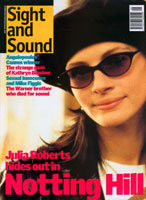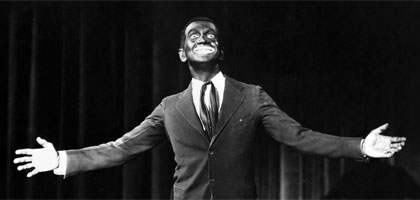
The Innovators 1920-1930: Now You Has Jazz

In the 20s Hollywood was not interested in the talkies. Then Sam Warner saw the potential for "canned vaudeville", and made it happen. By Laura Mulvey
The brothers Warner as innovators? Jack - no. Harry - yes. But Sam...?
The brothers Warner who became Warner Bros. were four of a large family whose parents, along with many other Eastern European Jews, arrived in the United States in the 1880s. Harry, Albert, Sam and Jack turned separately and collectively to any entrepreneurial activity that came their way until they got into the nickelodeon business. Nowadays Jack, who is identified with Warners in its heyday, is the only brother still commonly remembered. But without Harry and Sam's different but complementary talents the studio would never have reached the big league. They did it by gambling on a new technology: synchronised sound for motion pictures. Here Harry's careful but inspired business management put the company in a position to capitalise on Sam's big idea.
A technological revolution of the kind that swept through the film industry with the arrival of synchronised sound recording is necessarily the product of cultural and economic factors and the culmination of many experiments over an extended period of time. But there are three reasons to celebrate Sam Warner's individual contribution to the advent of talking pictures in Hollywood. First, there should be a place for acknowledging the contingent, almost accidental factors which affect history such as personal obsession or subjective choice, chance elements which may provide the push that sets a historical drama in motion. Second, The Jazz Singer (1927), the best-known Warner sound vehicle, represents a key moment in the history of the US entertainment industry and records the tensions in US popular culture at a transitional moment. And third is the way the personal contribution Sam made to the coming of synch sound was dramatically realised.
Sam was a believer. He threw himself, in the words of a contemporary Warner Bros. technician, "hook, line and sinker" into sound cinema, taking responsibility for producing all the studio's early programmes, culminating in his tireless supervision of the production of The Jazz Singer. Its opening, in Warners' New York theatre, was timed to coincide with the Day of Atonement, which forms the backdrop to the story's narrative climax. Harry and Jack were in New York, expecting Sam and Abe to join them from Los Angeles. But Sam was in hospital after an operation on his chronic sinus condition revealed a serious mastoid infection. He died, aged 42, only hours before his brothers managed to reach the West Coast. It was generally believed that the gruelling task - from June 1925 to October 1927 - of launching Warners' first sound pictures had literally killed him.
But before Sam could inflect the Warner Bros. story Harry had to establish a solid economic base for expansion. In the mid 20s the US economy was booming, with confidence high as the boom had been gathering momentum since the Depression of the 1890s. The film industry had grown up within these conditions, had become 'Hollywood', and had by and large consolidated into an oligopoly of five major studios with vertically integrated control of production, distribution and exhibition, whose products also dominated foreign markets. These studios had no interest in rocking their successful industry by fooling around with new technologies and had turned their backs on the idea of talking pictures. So it was the hungry outsiders - the brothers Warner and William Fox - who were prepared to take chances in the hope of breaking into the closed circle of the 'majors'.
At the beginning of 1925 Warner Bros. had no first-run theatres and no international distribution, both necessities for 'major' profits and status. Harry, who had run the brothers' finances since Sam acquired their first projector to exhibit The Great Train Robbery in 1903, was on the look out for a large amount of outside investment to fund his expansion plans. At the same time Waddill Catchings, an investment banker with Goldman, Sachs, was on the look out for another suitable business to launch into a major national enterprise. (He had already masterminded the growth of Woolworths and Sears Roebuck.) He approved of the way Harry ran Warner Bros. and agreed to raise bank credit to finance a "master plan" of expansion and to join the board of directors. Catchings' Wall Street credibility opened the doors of banks that would never otherwise have considered lending to the film industry. During 1925 Warner Bros. acquired the old Vitagraph Company, including its Brooklyn studio, its distribution structure and ten major theatres. In this phase of the expansion the question of sound never arose, but sound was the basis for what was to become the second phase.
Despite the major studios' complacency, it was inevitable by the mid 20s that sound film would become a reality. On the one hand, by 1924 the basic technology was in place, developed in Bell Labs., the research wing of Western Electric. On the other, the entertainment industry was becoming increasingly dominated by new sound technologies. Radio and the record companies had opened up a mass market for popular music, while dancehalls and vaudeville were booming. After all, this was the jazz age - and the movies were getting left behind, out of synch with the music-suffused atmosphere of the times.
As part of its first expansion plan Warner Bros. acquired a radio station, the first Hollywood studio to do so. KWBC marked the transition to phase two. The station gave Sam, who ran it, the opportunity to develop his interest in electronics. He became personal friends with the Western Electric representative in Los Angeles, Nathan Levinson, who invited him to a demonstration in New York of the results of the company's research and development into sound synchronisation for film. Sam saw immediately that sound could offer the competitive edge that would take Warner Bros. beyond Harry's safe course of expanded vertical integration into all the pitfalls and possibilities of a major financial gamble. His problem would be to convince Harry there was a future in synchronised sound.
The various stories of how Sam tricked Harry into attending a demonstration at Bell Labs. in May 1925 are now part of movie legend. Harry shared the rest of the movie industry's opinion of talking pictures; both his and Sam's accounts of what happened confirm that any idea of "talking" was avoided. Sam persuaded Harry to attend a demonstration of "an instrument that would bring the best music, the best voices and the best instrumentation to the smallest places in the world." The demonstration film included a small band playing jazz. Sam recalls: "He fell harder than I did."
For the Warners synchronised sound did not mean the talkies; it simply meant the addition of song and music to motion pictures. Harry, who with his sister Rose had won dance championships in his youth, is said to have remarked revealingly to Catchings: "If it can talk, then it can sing." This sentiment was certainly in keeping with the live performance/screen crossover spirit of an era when it was customary for exhibitors to put on vaudeville acts as prologues to a main feature. At the same time Broadway was witnessing a series of smash-hit variety shows, and to film their popular song-and-dance numbers would be to extend these live acts into mechanical reproduction and mass distribution. The first intended use of sound cinema, therefore, was for "canned vaudeville".
After Warners' and Western Electric's first agreement in June 1925 Sam devoted himself to the process of learning about sound recording and to making short films as prologues. Warner Bros. and Western Electric formed the Vitaphone Corporation in April 1926, giving Warners the exclusive licence to record and reproduce sound films on Western Electric equipment. Sound technology evolved out of electronics, and one of its key elements was the audion vacuum tube (originally developed by Lee de Forest) for amplifying sound in cinemas. For recording, Western Electric concentrated on the sound-on-disc method.
Western Electric was owned by AT&T, which by the mid 20s was one of the largest companies in the world. Not only had it been able to fund research and development at Bell Labs., but it could buy up patents, fight off challenges from other patent holders and most importantly activate the conversion of theatres to sound, providing skilled technicians and where necessary subsidising exhibitors who could not afford to have their theatres wired. Ultimately it would prove impossible for Warner Bros. to maintain an exclusive licence on the production of Western Electric sound films, but by that time the studio had reached equal status with the big five and moved its sound operations from New York to Hollywood.
